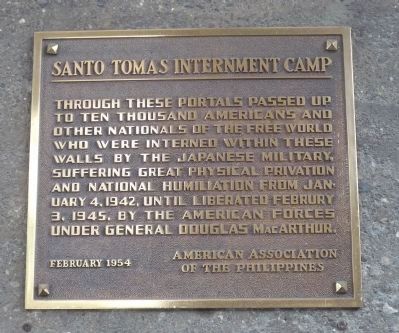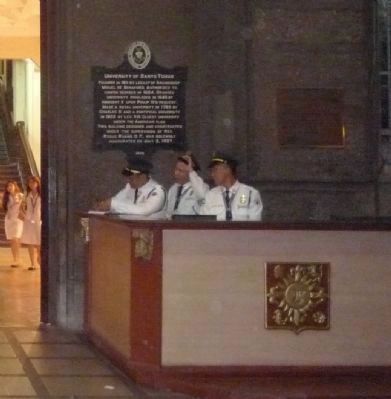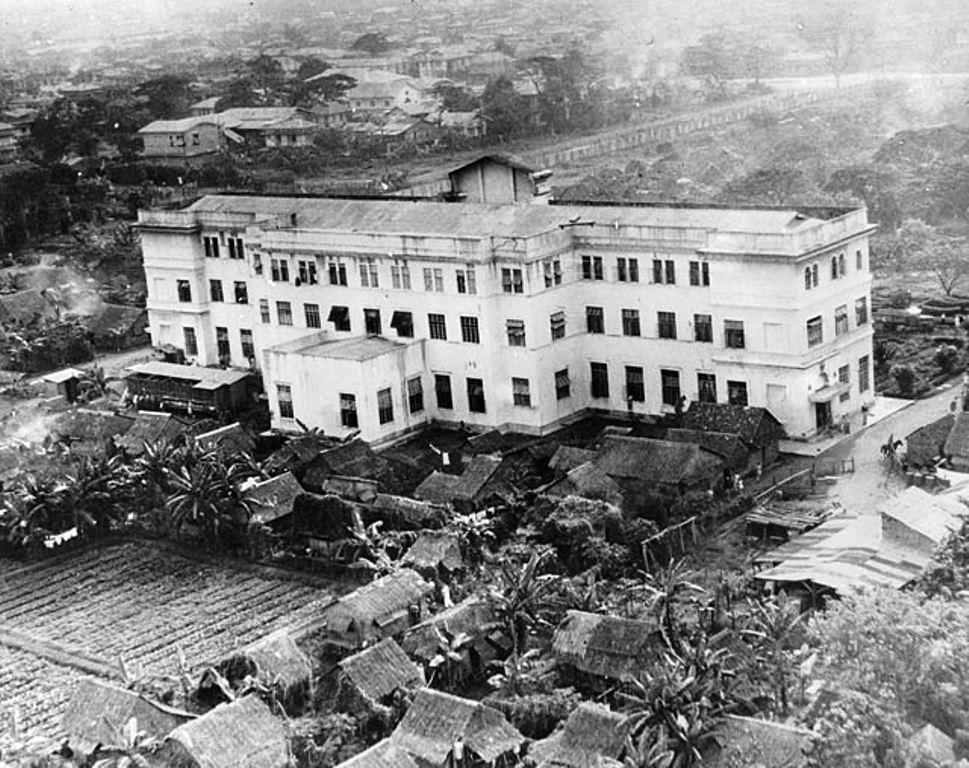Santo Tomas Internment (POW) Camp Marker
Details:
Just inside the entrance to the main building on the right-hand side wall.
A brass inscribed plaque about 2 feet by 2 feet.
Santo Tomas Internment Camp, also known as the Manila Internment Camp, was the largest of several camps in the Philippines in which the Japanese interned enemy civilians, mostly Americans, in World War II. The campus of the University of Santo Tomas in Manila was utilized for the camp, which housed more than 3,000 internees from January 1942 until February 1945. Conditions for the internees deteriorated during the war and by the time of the liberation of the camp by the U.S. Army many of the internees were near death from lack of food.
Units of the 1st Cavalry Division liberated the prison on February 3, 1945.
From the 1st Cavalry Division Association website:
Legend has it that General MacArthur was so impressed by the Cabanatuan raid by elements the 6th Ranger Battalion – which was still in progress at the time – that he went immediately to MG Mudge’s 1st Cavalry Division headquarters in Guimba. There he ordered the formation of a ‘Flying Column’ to accomplish the same thing with the 3,700 civilians interned at the University of Santo Tomas in Manila. Nobody knew about the 1,300 or so military and civilian prisoners at the old Bilibid prison which was only a few blocks from Santo Tomas.
Inside the prison camp, 3,700 apprehensive civilian men, women and children were watching the approach of the tracer-bullet fireworks in the evening sky with a strange mixture of excitement and dread. After three years in the “protective custody” of the Japanese Army, they were excited that SOMETHING was happening – even if they didn’t know what it was – but mixed in with this excitement was dread of the possibility that the pyrotechnic display was, in truth, being caused by the bad guys headed their way with malice in their souls. Rumors had been rampant for some time that the Japanese intended to kill all of their prisoners.
Late on 3 February 1945, after a couple of wrong turns and some heavy fighting in the mixed-up outskirts of Manila, the Santo Tomas column picked up CPT Manuel Colayco, a Filipino newspaperman and clandestine intelligence officer, who guided them to the main gate of the prison camp. At about nine in the evening, after a brief flurry of resistance by the Japanese guards during which CPT Colayco was fatally wounded by a grenade explosion, the 44th Tank Battalion’s M-4 Sherman “Battlin Basic”, closely by the “Georgia Peach” knocked down the gate and the war was nearly over for the internees.
The Flying Column was 66 hours into its mission. With time out for the fights at Cabanatuan and Gapan, and delays in bypassing some of the blown bridges, it had covered 100 miles. The 1st Cav had toeholds – tenuous as they might actually have been – at Santo Tomas and at the Malacanang Place
For the Santo Tomas internees, their liberation was followed by a night of delirious happiness, a standoff and hostage crisis in one of the campus buildings, and two or three days of murderous artillery dueling.
The artillery battle resulted when the few hundred men of the 1st Cav, not having all that much Manila real estate under their control, had to set up their artillery inside the Santo Tomas complex and begin making enough noise to discourage thoughts of counterattack in the minds of Admiral Iwabuchi and his twenty thousand marines defending Manila. The good news was that no counterattack materialized; the bad news was that the presence of American artillery in the front yard invited counterfire from the Japanese, and the internees were in the middle. This several day artillery duel caused the only prisoner causalities of the Santo Tomas liberation – with the possible exception of a couple of internees who reportedly ate themselves to death in the first day or so. Seventeen internees and several 1st Cav Troopers were killed in this exchange of fire and many more were injured.
After the shooting died down, only a couple of months of stomach aches from the unaccustomed good food and headaches from the seemingly endless interminable processing stood between the ex-prisoners and, for many of them, repatriation.
Among the many prisoners were many who completed the Bataan Death March and the Nurses – “Angels of Bataan and Corregidor”. One of the liberated prisoners was a World War 1 veteran, Frank Buckles. Frank Buckles would be the last living American World War 1 Veteran who died in 2011.
Another prisoner who was executed by the enemy just before liberation was Walter Loving, a Spanish War veteran and acclaimed musician, composer, who organized and directed the world-renowned Philippine Constabulary Band prior to the war.
For other POW Camps Memorials and historic raids to liberate them see this website:
Cabanatuan- POW Camp
Santo Tomas Internment (POW) Camp Marker
Palawan WWII Massacre Memorial (POW Camp 10A)
Palawan Survivors Memorial (POW Camp 10A).
Palawan Prison Camp (POW Camp 10A)- Philippine Historic Marker
11th Airborne Division- Los Baños Raid Marker
Hellships Memorial
Monument Text:
SANTO TOMAS INTERNMENT CAMP
THROUGH THESE PORTALS PASSED UP
TO TEN THOUSAND AMERICANS AND
OTHER NATIONALS OF THE FREE WORLD
WHO WERE INTERNED WITHIN THESE
WALLS BY THE JAPANESE MILITARY,
SUFFERING GREAT PHYSICAL PRIVATION
AND NATIONAL HUMILIATION FROM JAN-
UARY 4, 1942, UNTIL LIBERATED FEBRUARY
3, 1945, BY THE AMERICAN FORCES
UNDER GENERAL DOUGLAS MACARTHUR.
|
FEBRUARY 1954 |
AMERICAN ASSOCIATION OF THE PHILIPPINES |
Commemorates:
People:
Josephine May “Mama Josie” Nesbit Davis
Maude Campbell Davison Jackson
Helen “Cassie” Cassiani Nestor
Units:
1st Cavalry Division
1st Cavalry Division (Flying Column)
44th Tank Battalion (12th Armored Division)
8th Cavalry Regiment, 1st Cavalry Division
Filipino Guerillas
Philippine Scouts
South West Pacific Area (Command)
United States Army Nurse Corps
Wars:
WWII
Battles:
Luzon (1944-1945)
Pacific Theater
Philippines Campaign (1944–1945)
Other images :



